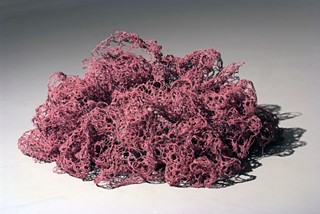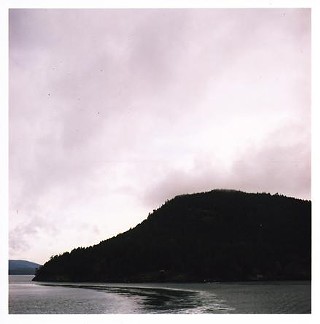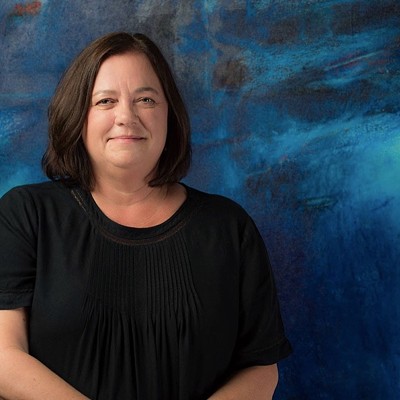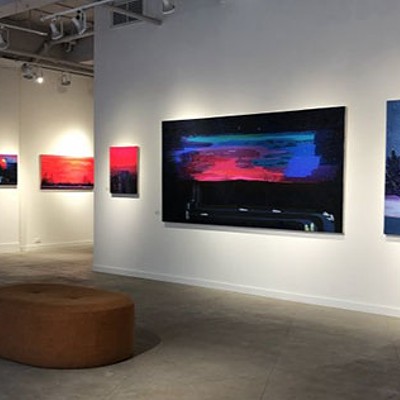Weird things floating in the waters of city harbours are hardly unusual, so, at first glance, photographs of Doug Guildford's nets and other sculptural pieces bobbing in the water against the Toronto skyline might not look out of the ordinary. Guildford, a Halifax-raised artist who's made Toronto his home for 30 years, still strongly feels the lure of the ocean. Since acquiring two properties in Lunenburg County, he's split his time between Nova Scotia and Ontario, his studio practice heavily influenced by summers on the south shore. He's also lived in Vancouver and spent time house-sitting for artist friends on Toronto's Ward's Island, so water is predominant in his psyche.
Guildford's background was in printmaking---still present in the exhibit, but not the highlight---and it was nine years ago that he began the body of sculptural work that dominates his show Between the Tides at Saint Mary's University Art Gallery. Initially focusing on natural elements, plants and plankton-like life forms in the water, he gradually became interested in the human-made items he found along the coastline, what he refers to as "cultural debris." His sculptural works integrate found nets, buoys and floats, or use materials like wire and thread to evoke these objects.
Delicate and ambiguous, his sculptures could be netting or aquatic life forms. He crochets wire, extends found nets with wool or wire, or knits structures to entangle buoys. "Skirt," a net of pink wire still attached umbilically to its reel, brings to mind knitted works by artists like Germaine Koh. It's common for female artists to use traditionally feminine crafts like crocheting to make a statement about gender roles, but less so for male artists.
Guildford acknowledges this importance of the idea of gender within his work. He notes a divide between his more masculine pieces---ones like "Net," a large structure of steel wire and glass hung on the wall, and other works with sturdier materials---compared to "Heirloom," a new work that's simply a crocheted silk cloth, albeit one that suggests a net or seaweed. As a gay man, Guildford is interested in the ambiguity of gender he found in aquatic creatures: how some animals change their gender throughout their life, and a generally "less dichotomous territory of nature."
The artist is also interested in engaging with the social history of the area. Born in Shelburne County, since taking up summer residence at his Lunenburg home, he says, "It's been great to find a sense of community---meeting people my age who never left the area." Speaking from his Toronto studio where, ironically, he's worried a thaw will cause flooding in his work space, he says, "It's easy to romanticize this, and I do," but does it with a strong interest in the culture of the area he left as a child. When the lobster market began collapsing in the fall, he followed the dilemmas of local fishers closely, both sympathetic to his friends and envious of their lifestyle.
Outside of the gallery, the sculptures have all taken their turns being displayed in harbours and coastlines, but Guildford says he's mostly been "sneaking around with them," photographing them more or less privately. "I've been wanting to more brazenly go in that territory [of public display]," he says. "I'm not going to the government wharf---but I want to." He calls this a "rough version of the formal gallery." One piece was displayed near the ferry docks at Ward's Island in Toronto and people got curious as he installed it---crossing the divide between art and the public works department.
Pictures of Guildford's nets being washed by waves along shorelines recall the earth art movement, particularly the water-based sculptures of Robert Smithson or Andy Goldsworthy, or Ana Mendieta's questioning of gender through earthworks. But the placement of his work in Halifax feels charged in another way: it hasn't been long that our oft-failing sewage treatment plant has been in operation. Local artists have collected rocks, seaweed and tampon applicators in gallery spaces, and one of the highlights of the show is browsing a collection of Guildford's sketchbooks and oceanic debris. Guildford's recycling of ocean garbage feels like a nod to ecology and call for an awareness of what's washing up on our shores.
Doug Guilford's Between the Tides at Saint Mary's University Art Gallery until February 22. Catalogue launch, Thursday, February 19, 8pm.














